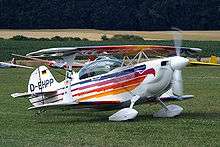Aviat Eagle II
| Eagle II | |
|---|---|
 | |
| Role | Aerobatic aircraft |
| Manufacturer | Christen Aviat |
| Designer | Frank Christensen |
| First flight | February 1977 |
|
| |

The Christen Eagle II, which later became the Aviat Eagle II in the mid-1990s, is an aerobatic sporting biplane aircraft that has been produced in the United States since the late 1970s.
Design
Designed to compete with the Pitts Special by Frank Christensen originally of Salt Lake City,[1] Utah, the Eagle II is marketed in kit form for, homebuilding. It set a new standard for completely documented homebuilding kits that revolutionized the homebuilding industry. The Eagle II is a small aircraft of conventional configuration with single-bay, equal-span staggered biplane wings braced with streamlined flying and landing wires and a I-strut to form a box truss. The pilot and a single passenger sit in tandem underneath a large bubble canopy. The tailwheel undercarriage is fixed, with the mainwheels mounted on spring aluminum legs. The main wheels are housed in streamlined fairings. The fuselage and tail are constructed of chromoly steel welded tube, with the forward fuselage skinned in aluminum and the rear fuselage and tail covered in fabric. The wing structure is Sitka spruce wood and fabric covered. The engine cowling is fiberglass. By 2011 over 350 aircraft were flying.[2]
Operational history

In 1979, the Eagles Aerobatic Team (Charlie Hillard, Tom Poberezny, and Gene Soucy) chose the Christen Eagle as a replacement for their Pitts Special airshow act "The Red Devils". The act continued until 1995. All three Christen Eagles hang from the lobby of the EAA Airventure Museum in Oshkosh, Wisconsin.[3]
Variants
- Christen Eagle I
- Single Seat Variant. Lycoming AEIO-360 200 hp (150 kW). First design model, built at the San Carlos Airport.
- Christen/Aviat Eagle II
- Most common variant, two seat dual controls. Lycoming AEIO-360 200 hp (150 kW).
- Christen Super Eagle
- Very rare, only one or two built. Lycoming AEIO-540 300 hp (220 kW).
Specifications
General characteristics
- Crew: One pilot
- Capacity: 1 passenger
- Length: 17 ft 11 in (5.46 m)
- Wingspan: 19 ft 11 in (6.07 m)
- Height: 6 ft 6 in (1.98 m)
- Wing area: 125 ft2 (11.6 m2)
- Empty weight: 1,025 lb (465 kg)
- Gross weight: 1,578 lb (716 kg)
- Powerplant: 1 × Lycoming AEIO-360-A1D, 200 hp (149 kW)
Performance
- Maximum speed: 184 mph (296 km/h)
- Range: 380 miles (610 km)
- Service ceiling: 17,000 ft (5,180 m)
- Rate of climb: 2,100 ft/min (11 m/s)
See also
- Aircraft of comparable role, configuration and era
References
| Wikimedia Commons has media related to Christen Eagle. |
- ↑ Frank L. Christensen
- ↑ Bayerl, Robby; Martin Berkemeier; et al: World Directory of Leisure Aviation 2011-12, page 94. WDLA UK, Lancaster UK, 2011. ISSN 1368-485X
- ↑ "Christen Eagles". Archived from the original on 19 July 2011. Retrieved 29 March 2011.
- Taylor, Michael J. H. (1989). Jane's Encyclopedia of Aviation. London: Studio Editions. p. 254.
- Jane's All the World's Aircraft 1987-88. London: Jane's Yearbooks. pp. 585–85.
- Manufacturer's website
- Cavanaugh Flight Museum's Christen Eagle II